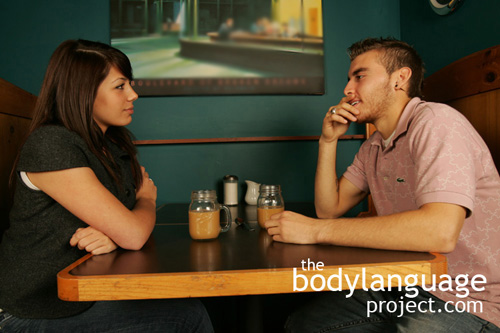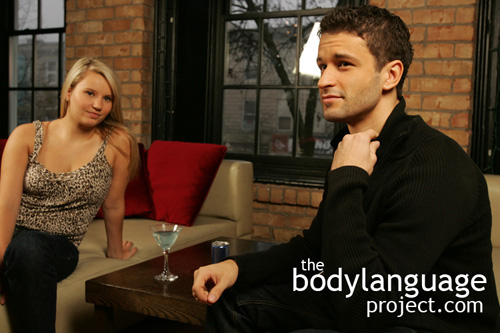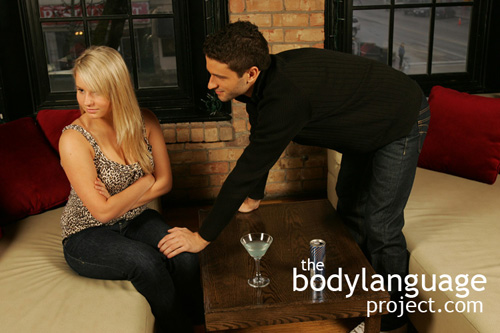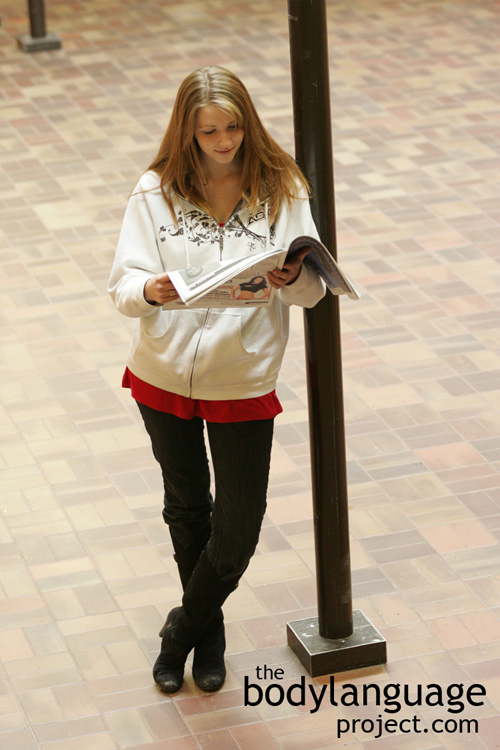Body Language of The Contempt Facial Expression and Contempt Smile
 Cue: Contempt Facial Expression and Contempt Smile
Cue: Contempt Facial Expression and Contempt Smile
Synonym(s): Contempt Smile.
Description: In the contempt facial expression, wrinkles appear on the nose with one lip often raised to form a sneer. The eyes narrow. Lips are frequently pushed forward with a tight mouth raised slightly at the corners. The chin usually drops, or lifts and the head turns to the side.
The contempt smile happens when the corners of the lips are tightened unevenly and one side is lifted slightly higher than the other. In this case, the eyebrows are slightly raised. The smile might also push the lower lip up by the chin muscle and pull the corners of the mouth down. This is often coupled with lowered brows.
In One Sentence: The contempt facial expression is a tensing around the nose with one lip raised and serves to demonstrate disagreement.
How To Use it: Use the expression to show others that you are not in agreement but do not wish to do so overtly in a verbal fashion. A micro-sneer can be sent when you want to give a subtle hint of disapproval. The cue works in any context as it permits one to tow the line of confrontation with a subtle nonverbal expression. In this capacity, people will understand that you are not in agreement, but will not be able to hold you to it as the cue is fleeting and barely noticeable. Therefore, the cue is useful for expressing disapproval and disagreement without being overt.
Context: General.
Verbal Translation: “I really don’t like what you’re saying or doing and so my face is scrunching up as if there is a malodor.”
Variant: Variants exist of high and low contempt smiles. These are demonstrated through degrees of stress across the face.
As high contempt is reached, the cues become more obvious. Disgust is close to Contempt and usually causes people to look downward on other people. Lint picking, avoiding eye contact, turning the body away can all show various degrees of contempt. Contempt can also be a microexpression and flash so quickly that it is barely noticed. Watch for the microexpression of the nose sneer or the eyes narrowing quickly.
Cue In Action: The conversation turned from bad to worse as it shifted onto politics. When they couldn’t see eye-to-eye on the matter, he wrinkled his nose, narrowed his eyes and tightened his lips while shaking his head in disgust. The message was clear.
Meaning and/or Motivation: Contempt is an emotion designed to show disagreement and an inability to see eye-to-eye on matters. Some contempt runs deeper than others and can be amplified with additional cues that come across as attacks. Contempt can be high or low, delivered by the relative strength of the associated cues.
Cue Cluster: Contempt is accompanied by looking downward, palms up in a “what are you doing posture,” sneering, pulled up nose, pursed lips, and head turned away.
Body Language Category: Dislike (nonverbal), Indicators of disinterest (IOD), Microexpressions, Negative body language, Rejection body language, Suspicious body language or suspicion, Universal facial expressions.
Resources:
Aranguren, Martin. “Nonverbal interaction patterns in the Delhi Metro: interrogative looks and play-faces in the management of interpersonal distance.” Interaction Studies. 2016. 16(1) forthcoming.
http://bodylanguageproject.com/articles/seriously-stop-touching-use-nonverbal-signaling-manage-unwanted-touching-busy-public-areas
Aranguren, Martin and Stephane Tonnelat. Emotional Transactions in the Paris Subway: Combining Naturalistic Videotaping, Objective Facial Coding and Sequential Analysis in the Study of Nonverbal Emotional Behavior. Journal of Nonverbal Behavior. 2014. 38:495–521. DOI 10.1007/s10919-014-0193-1
Bard, K. A. (2003). Development of emotional expressions in chimpanzees (Pan troglodytes). In P. Ekman, J. Campos, R. J. Davidson & F. B. M. De Waal (Eds.), Emotions inside out: 130 years after Darwin’s The Expression of the Emotions in Man and Animals (Vol. 1000, pp. 88-90). New York: Annals of the New York Academy of Sciences.
Baron, R. M., & Kenny, D. A. (1986). The moderator-mediator variable distinction in social psychological research: Conceptual, strategic, and statistical considerations. Journal of Personality and Social Psychology, 51(6), 1173-1882.
Biehl, M., Matsumoto, D., Ekman, P., Hearn, V., Heider, K., Kudoh, T., et al. (1997). Matsumoto and Ekman’s Japanese and Caucasian Facial Expressions of Emotion (JACFEE): Reliability Data and Cross-National Differences. Journal of Nonverbal Behavior, 21, 3-21.
de Waal, F. B. M. (2003). Darwin’s legacy and the study of primate visual communication. In P. Ekman, J. Campos, R. J. Davidson & F. B. M. De Waal (Eds.), Emotions inside out: 130 years after Darwin’s The Expression of Emotion in Man and Animals (pp. 7-31). New York: New York Academy of Sciences.
Ekman, P. (1994). Strong evidence for universals in facial expressions: A reply to Russell’s mistaken critique. Psychological Bulletin, 115, 268-287.
Ekman, P., Friesen, W. V., O’Sullivan, M., Chan, A., Diacoyanni-Tarlatzis, I., Heider, K., et al. (1987). Universals and cultural differences in the judgments of facial expressions of emotion. Journal of Personality & Social Psychology, 53(4), 712-717.
Ekman, P., Levenson, R. W., & Friesen, W. V. (1983). Autonomic nervous system activity distinguishes among emotions. Science, 221(4616), 1208-1210.
Ekman, P., O’Sullivan, M., & Matsumoto, D. (1991a). Confusions about context in the judgment of facial expression: A reply to “The contempt expression and the relativity
thesis.”. Motivation & Emotion, 15(2), 169-176.
Ekman, P., O’Sullivan, M., & Matsumoto, D. (1991b). Contradictions in the study of contempt: What’s it all about? Reply to Russell. Motivation & Emotion, 15(4), 293-296.
Elfenbein, H. A., & Ambady, N. (2002). On the universality and cultural specificity of emotion recognition: A meta-analysis. Psychological Bulletin, 128(2), 205-235.
Ekman, P., O’Sullivan, M., & Matsumoto, D. (1991a). Confusions about context in the judgment of facial expression: A reply to “The contempt expression and the relativity thesis.”. Motivation & Emotion, 15(2), 169-176.
Ekman, P., O’Sullivan, M., & Matsumoto, D. (1991b). Contradictions in the study of contempt: What’s it all about? Reply to Russell. Motivation & Emotion, 15(4), 293-296.
Girard, Jeffrey M.; Jeffrey F. Cohna; Mohammad H.Mahoor S.; Mohammad Mavadati;
Zakia Hammal; and Dean P. Rosenwalda. Nonverbal Social Withdrawal In Depression: Evidence From Manual And Automatic Analyses. Image and Vision Computing. 2013.
http://bodylanguageproject.com/articles/body-language-signals-withdrawal-depression
Reed, Lawrence Ian; Katharine N. Zeglen and Karen L. Schmidt. Facial Expressions as Honest Signals of Cooperative Intent in a One-Shot Anonymous Prisoner’s Dilemma Game. Evolution and Human Behavior. 2012. 33: 200-209. http://bodylanguageproject.com/articles/body-language-signals-withdrawal-depression/
Kahlbaugh, Patricia ; Haviland, Jeannette. Nonverbal communication between parents and adolescents: A study of approach and avoidance behaviors. Journal of Nonverbal Behavior. 1994 18(1): 91-113.
Leanne Brinke, Sarah MacDonald, Stephen Porter, Brian O’Connor. Crocodile Tears: Facial, Verbal and Body Language Behaviours Associated with Genuine and Fabricated Remorse. Law and Human Behavior, 2012; 36(1): 51-59.
http://bodylanguageproject.com/articles/crocodile-tears-humans-show-greater-range-of-emotions-and-speech-hesitation-during-fake-remorse/
Levenson, R. W., Ekman, P., & Friesen, W. V. (1990). Voluntary facial action generates emotion-specific autonomic nervous system activity. Psychophysiology, 27(4), 363-384.
Levenson, R. W., Ekman, P., Heider, K., & Friesen, W. V. (1992). Emotion and autonomic nervous system activity in the Minangkabau of West Sumatra. Journal of Personality & Social Psychology, 62(6), 972-988.
Matsumoto, David. Scalar Ratings Of Contempt Expressions Journal of Nonverbal Behavior. 2005. 29(2): 91-104.
Matsumoto, D. (1989). Cultural influences on the perception of emotion. Journal of Cross-Cultural Psychology, 20(1), 92-105.
Matsumoto, D. (1992). American-Japanese cultural differences in the recognition of universal facial expressions. Journal of Cross-Cultural Psychology, 23(1), 72-84.
Matsumoto, D. (2001). Culture and Emotion. In D. Matsumoto (Ed.), The Handbook of Culture and Psychology (pp. 171-194). New York: Oxford University Press.
Matsumoto, D., & Ekman, P. (1989). American-Japanese cultural differences in intensity ratings of facial expressions of emotion. Motivation & Emotion, 13(2), 143-157.
Matsumoto, D., Keltner, D., Shiota, M. N., Frank, M. G., & O’Sullivan, M. (2008). What’s in a face? Facial expressions as signals of discrete emotions. In M. Lewis, J. M.
Haviland & L. Feldman Barrett (Eds.), Handbook of emotions (pp. 211-234). New York: Guilford Press.
Matsumoto, D., & Willingham, B. (2009). Spontaneous Facial Expressions of Emotion of Congenitally and Non-Congenitally Blind Individuals. Journal of Personality and Social Psychology, 96(1), 1-10.
Mesquita, B., & Frijda, N. H. (1992). Cultural variations in emotions: A review. Psychological Bulletin, 112, 197-204.
Peleg, G., Katzir, G., Peleg, O., Kamara, M., Brodsky, L., Hel-Or, H., et al. (2006). Heriditary family signature of facial expression. Proceedings from the National Academy of Sciences, 103(43), 15921-15926.
Underwood, M. K.. Glares of Contempt, Eye Rolls of Disgust and Turning Away to Exclude: Non-Verbal Forms of Social Aggression among Girls. Feminism & Psychology. 2004 14(3): 371-375.
Weisfeld, Glenn E. and Jody M. Beresford. Erectness of Posture as an Indicator of
Dominance or Success in Humans. Motivation and Emotion. 1982. 6(2): 113-130.
http://bodylanguageproject.com/articles/body-language-cues-dominance-submission-children/
Zeinstra, Gertrude G.; M.A. Koelen; D. Colindres ; F.J. Kok; C de Graaf. Facial Expressions in School-Aged Children are a Good Indicator of ‘Dislikes’, but not of ‘Likes.’ Food Quality and Preference. 2009. 20: 620-624.
http://bodylanguageproject.com/articles/read-kids-dislike-food-facial-expressions-accurate-detecting-dislike-not-like-children/








